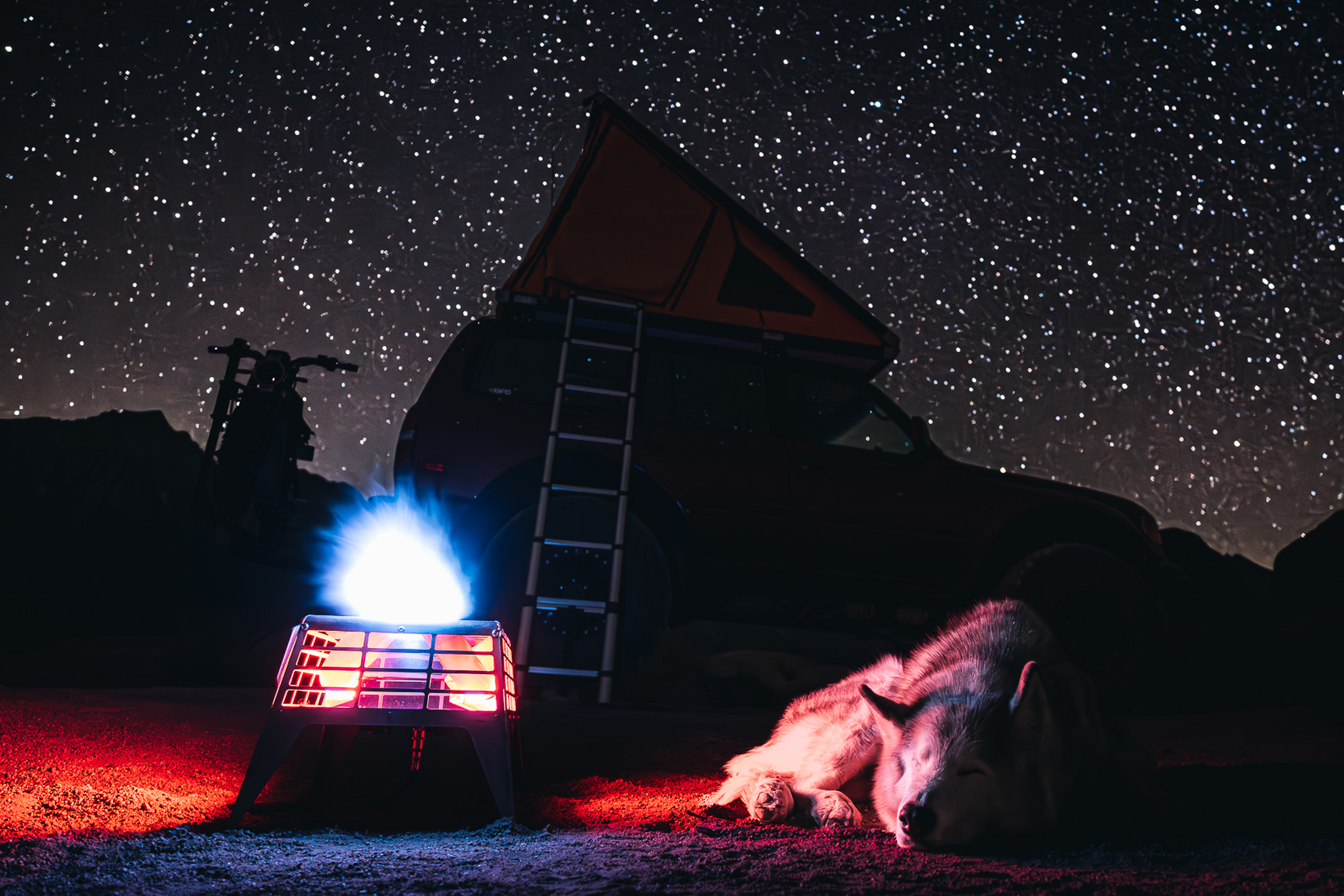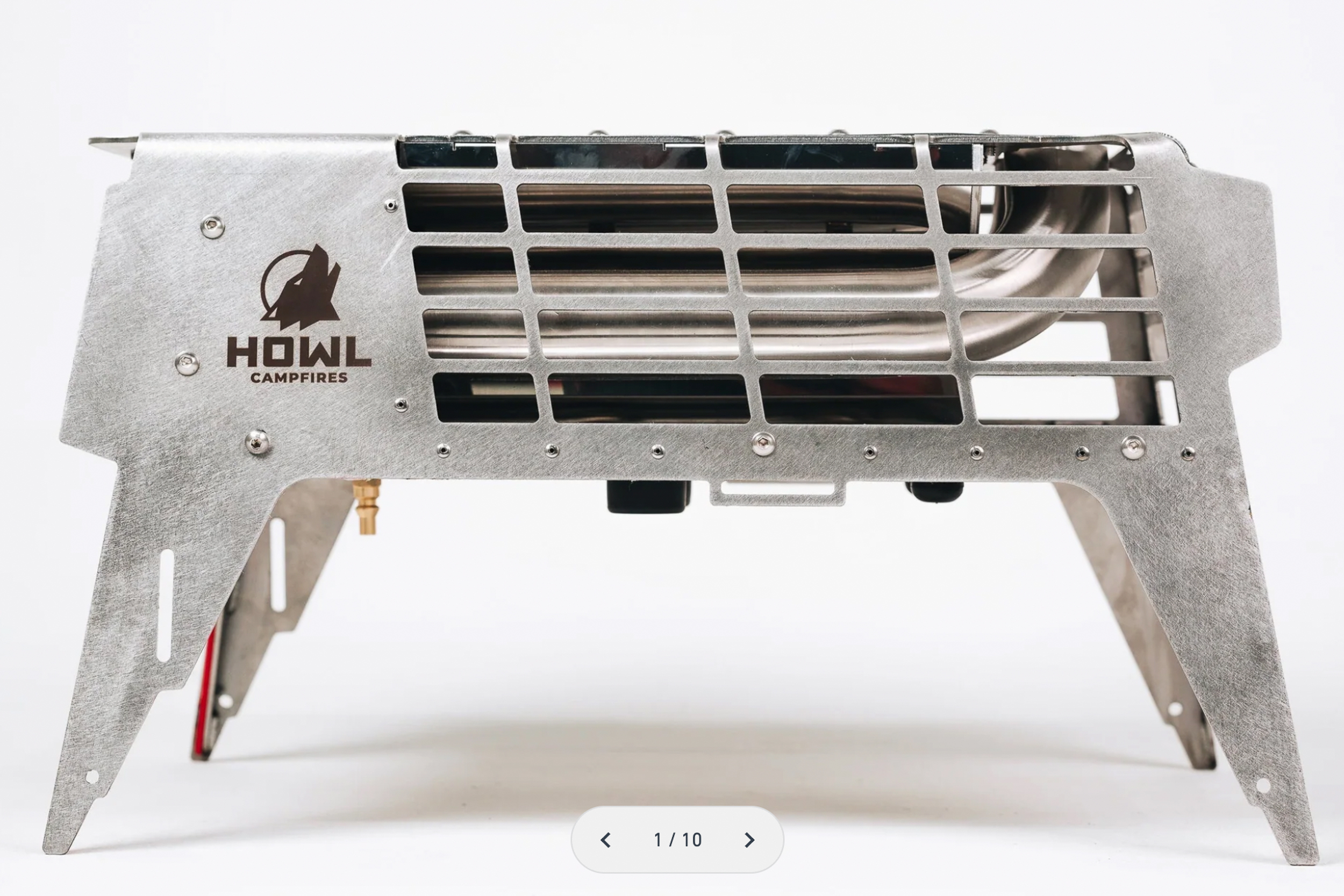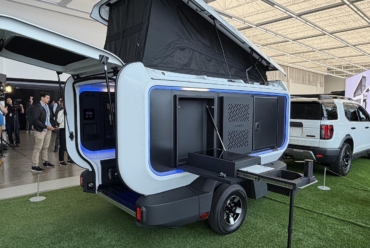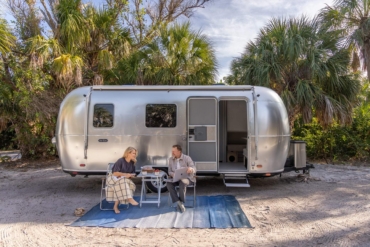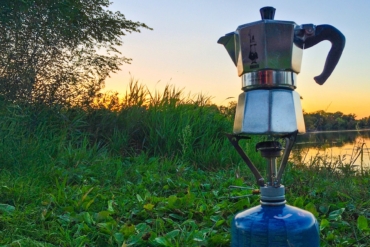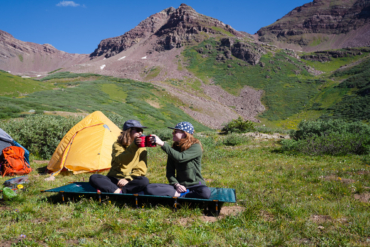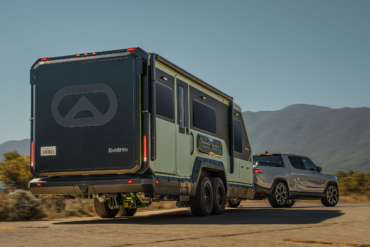The past few hellish summer drought seasons left real campfires in the realm of nostalgia. Almost every area in which I’ve camped in the last 2 years has been under burn bans most of the time, including on my own property.
Campfires generate ambiance, which is nice. But sometimes the heat they throw makes or breaks a shoulder season or winter outing. And the recent burn bans made smokeless fire pits and other artificial means of outdoor heat hot sellers.
I’ve tried several smokeless fire pits, propane heaters, and campfires over the last few winter seasons. Although some created the ambiance and light of a fire, none came close to throwing the desired heat. The necessary containerized combustion could produce the flame and light of a campfire, but the radiant heat of wood coals was always lacking. I could feel the heat when I was directly over the flames, but I would get chilled as soon as I moved away.
Howl Campfires boldly claims to solve all the issues of fire pits and propane heaters. I was skeptical. And when I saw the high MSRP of $1,299, my skepticism only grew. A four-digit propane campfire?
“This thing better make me want to take all my clothes off,” was my thought.
I tested the Howl Campfires Howl R4 during three cold, windy, and sometimes wet car camping outings. Temperatures dropped to just above freezing, and my campmates included my always-cold dog Patches and my daughter. Neither has my job as an outdoor gear tester, so they couldn’t count on layer upon layer of the best outdoor apparel. Patches hardly has any hair, and my daughter was amid a growth spurt, so clothing was sparse.
In short: The Howl R4 delivered, period. It threw out so much radiant heat that I often stripped down to base layers regardless of the temperatures. And just as important as the amount of heat, the R4 delivered it just like a real campfire does. The heat radiated out from the sides thanks to a high-tech feature, while open flames provided the ambiance and convective heat above the R4. The Howl R4, in a few ways, was even better than a real campfire. But — it’s $1,299!
- Main material: 1/8" 304 stainless steel plate, aircraft aluminum, and brass
- Weight: 34 lbs.
- Operating temperature: 1,200 degrees
- Burn time: At least 6.5 hours on a 20-lb. propane tank
Pros
- BarCoal radiant heat tubes deliver amazing warmth
- A-Flame top burner delivers ambiance and convective heat, even in high winds and rain
- Extremely robust construction
- Convenient and clever storage mode with 20-lb. propane tank
Cons
- High price
- Heavy
Howl Campfires Howl R4 Review
Howl R4 Nuts and Bolts
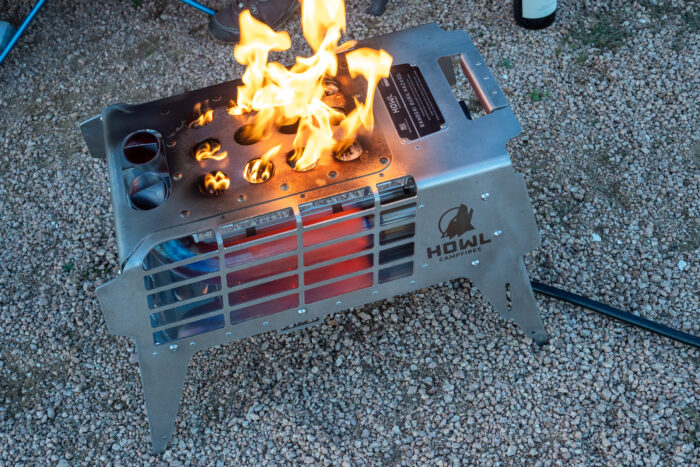
The Howl R4 arrived in a supremely packed box; short of launching it out of an airplane, no way it would be damaged during shipment. And even if the box and crate got pummeled, the campfire seemed indestructible from the get-go.
The hefty 34-pound weight of the Howl R4 hinted at the tank-like build quality. A single sheet of laser-cut ⅛-inch-thick stainless steel bent into form via a hydraulic press makes up the exoskeleton. Aircraft aluminum and brass complete the build.
There is zero plastic and no electronics. The Howl Campfires Howl R4 is one of the most overbuilt pieces of outdoor gear I have ever tested. If I ran my car into it, I’m 100% sure the car would bear the brunt of the damage.
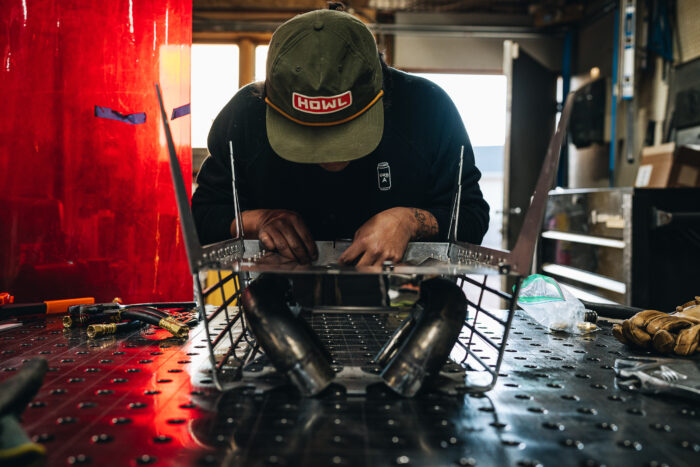
Howl Campfires bestowed two forms of burners on the R4. The one on top, which Howl dubs “A-Flame Burner,” seemed familiar, but the brand claims, “After years of mathematical modeling and experimentation, this is the brightest, cleanest, most weather-resistant flame ever created.”
Regardless of claims, the A-Flame Burner produced an open flame on top of the R4 and the resultant convective heat.
Howl Campfires calls the pair of unfamiliar burners on the sides of the R4 “BarCoal Burners.” It claims they are the first-ever naturally aspirated radiant tube heaters. These burners reminded me of dirt bike exhaust headers.
Howl says that with “100% primary air combustion, the system is unaffected by wind, while the drain ports shed rain and snow.”
Indeed, the unboxing was impressive. It’s also fully built in the USA and comprises mostly American components. The Howl R4 felt, looked, and seemed like a campfire without an equal. But then again, it had better be at $1,299.
Convective vs. Radiant Heat in a Campfire
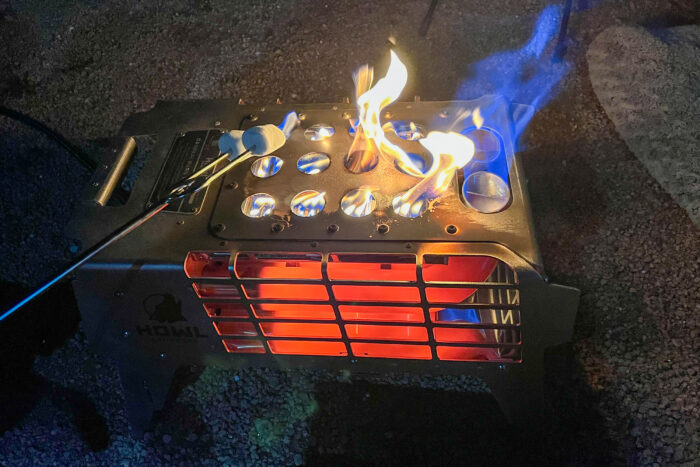
A fire is a fire, and hot is hot — or so I thought.
I never thought about how a campfire keeps you warm. That was until I started using smokeless fire pits and propane heaters when the burn bans became common. It turns out that there’s more to it than grunting, “Make fire, get warm.”
A campfire has three ways of delivering heat: conduction, convection, and radiation. Conduction involves transferring heat through touch. A burner’s surface gets hot; touching it can transfer enough energy to burn skin. But this isn’t a significant factor in campfires.
Convection happens when the fire heats the air, and then that air transfers the heat to your body. This is why the air above a flame can cause warming; but if it’s windy, that air blows away, and it cannot deliver the desired effect.
The Howl R4 delivers radiant heat through infrared (IR) waves. The glowing wood coals of a real campfire deliver this radiant heat, but propane heaters are not a significant source.
Wood coals emit IR in the spectrums most absorbable by water, raising the temperature with extreme efficiency. And, you guessed it, we are mostly made of water, making glowing wood coals an excellent heat source for humans and animals.
The Howl R4 is said to deliver the glow, ambiance, and convective heat via its A-Flame top burner and radiant heat through the pair of BarCoal radiant tube heaters.
Did the Howl R4 Live Up to the Hype (and Price)?
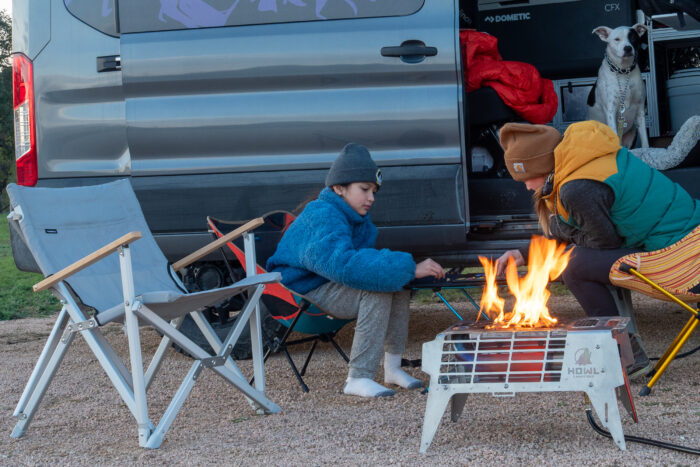
In a word, yes. Remarkably so.
Lighting the top-mounted A-Flame burner instantly produced the tepee-shaped flame of a larger wood campfire. Thanks to the internal windscreen, It was impervious to high and shifting winds. The flame quickly danced back to life after getting hit by water. The adjustability allowed flame sizes to go from barely there to pyromania-sized.
The convective heat directly above the flame was as expected and corresponded to flame size and, thus, fuel consumption. Besides the impressive wind and water resistance, the A-Flame burner didn’t surprise me, nor did it justify the price alone.
But I was about to experience the difference between the Howl R4 and other artificial campfires. The Bar-Coal twins came alive with a loud whoosh sound, and within a few minutes, each glowed a hot orange just like a four-stroke dirt bike exhaust header (for you moto-nerds on bikes with a way-too-lean fuel mixture).
Sitting even 2+ feet away, my shins started cooking. The radiant heat was much more intense and effective at heating my body than all the other smokeless fire pits and propane heaters/campfires I’ve tried combined.
I cannot overstate how warm the glowing, radiant tube burners were for my child, dog, and myself. Even with winds howling and the mercury near freezing, I had to turn the Bar-Coals down to lower settings (the brand claims they will hit 1,200 degrees). Although the A-Flame burners added a nostalgic ambiance and pleasant light, I felt like the bulk of the warming effect was due to the BarCoals.
I turned the A-Flame down until my daughter protested, as I wanted to save fuel for the radiant heat.
I was not aware of the different sources of heat in a campfire until I started using the Howl Campfires Howl R4. That’s when I fully realized what cooks have known about real wood fires: the coals are what you want to roast your food (and yourself).
Simultaneously, I realized why all previous smokeless fire pits weren’t that great at warming me. The “coals” are hidden behind steel walls. IR heat only works through a direct line of sight. So the warming effect was blocked unless I was directly above the fire.
Not so with the Howl R4.
Other Howl R4 Features
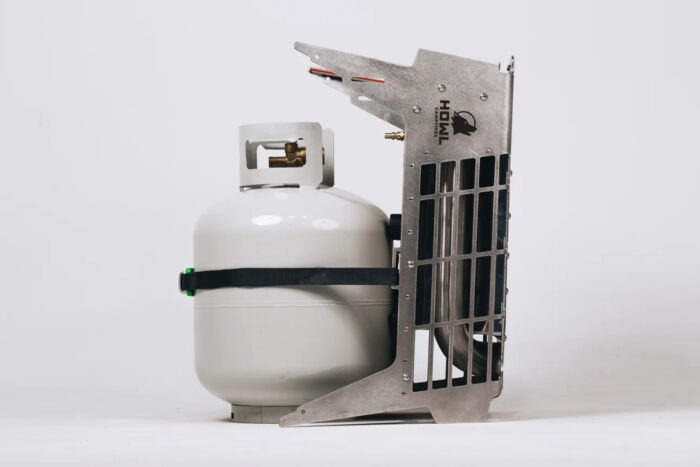
A common issue with propane camping accessories is the stowing of the awkward, round 20-pound propane tank. Over the decades, different-size propane tanks have rolled, slid, and flipped into destructive projectiles in my vehicles. Errant tanks that escaped tie-downs have damaged interior panels, bikes, and people.
The Howl R4 itself is also difficult to move and store; the heaviness, metal edges, and projecting legs don’t offer an easy, obvious way of transport.
But Howl Campfires got clever. The pitbull-esque R4 can stand vertically on an end, and the legs will straddle a 20-pound propane tank secured by an included strap. Then, slots in the exoskeleton made tying down the package easy and super secure. This proved rock solid in the back of my Subaru or van, and it took roughly the space of two bundles of wood.
I tested the Howl R4 in temperatures near freezing, extreme wind, and rain storms. None of these damped the effectiveness of the BarCoal radiant tube heaters or extinguished the A-Flame. I didn’t get to run the R4 at altitude, but Howl Campfires has tested the unit extensively and claims it will run no matter how high in the mountains you are.
Using an artificial campfire to comply with burn bans would be useless if the campfire itself wasn’t safe. And using an artificial campfire that isn’t UL- or CSA-certified is technically not allowed during burn bans. The Howl R4 is UL-certified and safe to use during burn bans.
Downsides
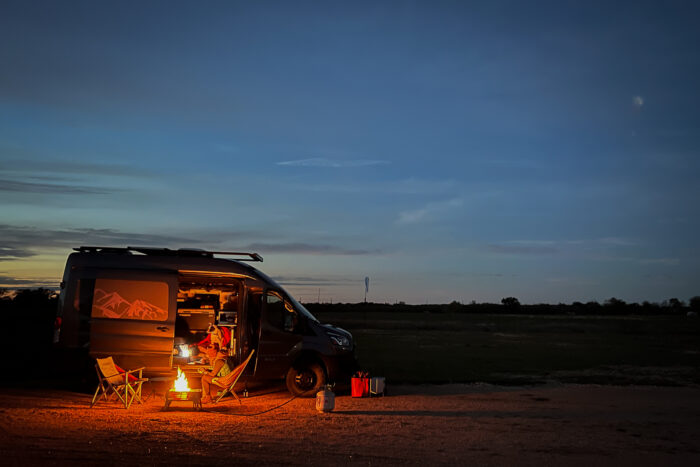
First and foremost is the $1,299 price tag. That catapults the Howl R4 from a camping purchase to an investment, so it’s not a decision to make based on one trip or even the first season of trips. Four digits for a campfire is a new level of pricing that will be hard for many to surmount. That would pay for multiple smokeless fire pits and other artificial campfires.
Secondly would be the relative heft. At 34 pounds, it was difficult for some to pack, unpack, and move. Combine that with the 20-pound propane tank, and you have a heavy, bulky package that was challenging for smaller campers to handle.
And lastly, the fuel consumption was higher than any other propane-powered camping accessory by a large margin. Howl Campfires claim a 6.5- to 10-hour burn time on a 20-pound propane tank, which I found accurate. Even given the ability to run at a lower level and still provide enough heat, 10 hours out of a tank sometimes felt wasteful compared to how long the same tank lasts running my stoves, ovens, and other things I’ve used while car camping.
But, to be fair, Howl Campfires claims that a propane tank provides the same heat as three bundles of wood.
Final Thoughts on the Howl Campfires Howl R4
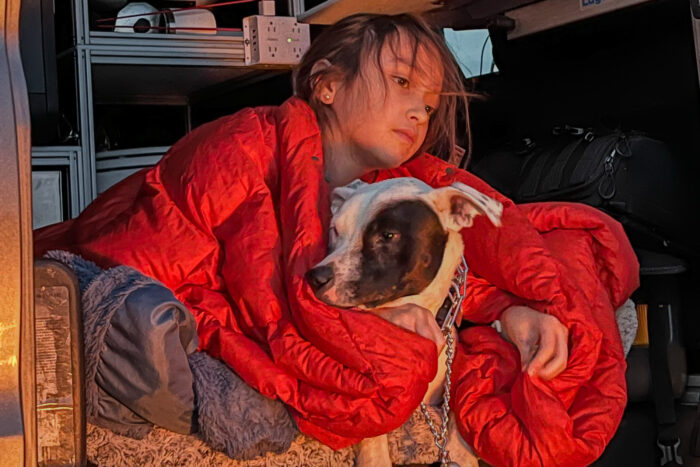
The Howl R4 was remarkably good at warming the crew. Howl Campfires built it like a tank, and it will become a family heirloom. And anyone near it when it was cold and dark claimed it was the best thing ever.
But that $1,299 price is hard to overlook, and the fuel consumption may turn some away.
Campfires have become relics of history in some areas over the last few years thanks to wildfires. Burn bans are common, so artificial fires may be one of the only legal and safe options for warming up and getting that full-on camping ambiance and experience. The Howl R4 is even better than wood fires in some ways, with advantages spanning beyond burn bans.
If you have the finances and are OK with the propane consumption, I am confident you will not find a better artificial campfire. I am equally sure that this furnace will someday become your kids’. My daughter loved the Howl Campfires Howl R4, which will outlive me, my friends, and all the pets. I know it will serve her and her crew well in the future. And that is an ROI I can live with.
